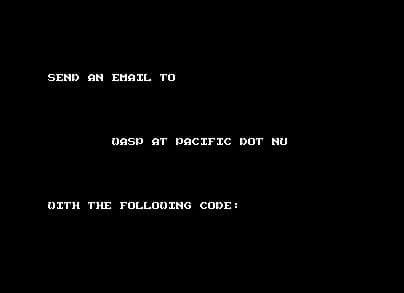
C64 invitation cracked!
On request, this is a brief writeup of my adventures cracking the hidden part
of the Datastorm 2017 Summer invitro by Fairlight. Spoilers ahead!
Having discovered the password entry screen that appears when you press space
during the end scroller, I quickly dived into the monitor and began to explore
the code. It became apparent that the password was used as the key for a very
professional-looking encryption algorithm (I later learned that it’s known as
RC4).
I spent a lot of time trying to reverse the cipher, but couldn’t find any
obvious weaknesses. And you simply can’t brute-force a 16-character password:
There are about 2^80 possibilities, and merely counting to that number on a
1 GHz processor would take 40 million years. And I only had two weeks.
But I noticed something interesting: The drive LED was making irregular
patterns of short and long flashes. Hmmm! I’m not skilled at reading Morse code
quickly, but it was easy enough to patch Vice to create a log file of all the
LED transitions with timestamps. Then I used “R”, the statistics program, to
visualise the data as a signal trace. Using Wikipedia’s Morse chart as a
reference I managed to decode something like:
LEGENDS NEVER DIE / FILTER / LIGHTHOUSE / TORUS / DISCO / STRING / SEVENTEEN /
FAIRLIGHT / NU
I jumped to the conclusion that “FAIRLIGHT NU” was just an advert for the
group’s regular site, and that the rest of the message was directly related to
the password. But when that didn’t yield any results, I briefly compared notes
with soci (hi!), who supplied the vital piece of information that the Morse
code message was pointing to a website with numbers on it. Knowing that, it was
straightforward to figure out that some of the spacing characters were dashes
and periods, and hence what the full domain name was supposed to be.
And sure enough, the site contained 19 large hexadecimal numbers of varying
lengths. What could they mean? Two of them began with “ea”, the opcode for the
NOP instruction, but overall they didn’t appear to be 6502 code. On a whim, I
googled the first number, and found a page that listed a lot of dictionary
words along with their MD5 and SHA-1 hashes. It turned out that the first two
numbers were the SHA-1 hashes of “alfa” and “bravo”. The remaining numbers
didn’t appear in Google’s index, except one which returned a small, unrelated
image. I later found out that this was the SHA-256 hash of the word “six”, so
presumably somebody was generating thumbnails with hash-based filenames, or
something along those lines.
But by now, all the evidence was pointing in one direction, so I wrote a bash
script that used the unix tool “shasum” to compute a variety of SHA-hashes for
the complete NATO phonetic alphabet, and check them against the list of
numbers. Sure enough, all nineteen numbers turned out to be hashes of code
words from that very alphabet. The first three (alfa, bravo, charlie) seemed to
serve as a hint to get people started, and the remaining sixteen, although they
didn’t spell out a regular word, were indeed the secret password that decrypted
the hidden part, in which a scroller told me to mail a secret code to wasp in
order to claim the golden ticket.
By now I had been staying up way too far into the early hours of the night, so
I sent the mail and promptly fell asleep. The next day it struck me that the
Commando music had been hinting at a military theme all along, perhaps
subconsciously priming my mind for Morse code and phonetic spelling alphabets.
All in all, this was an enjoyable and, yes, t-t-t-tricky challenge. Thank you
very much, moh and company!
LFT